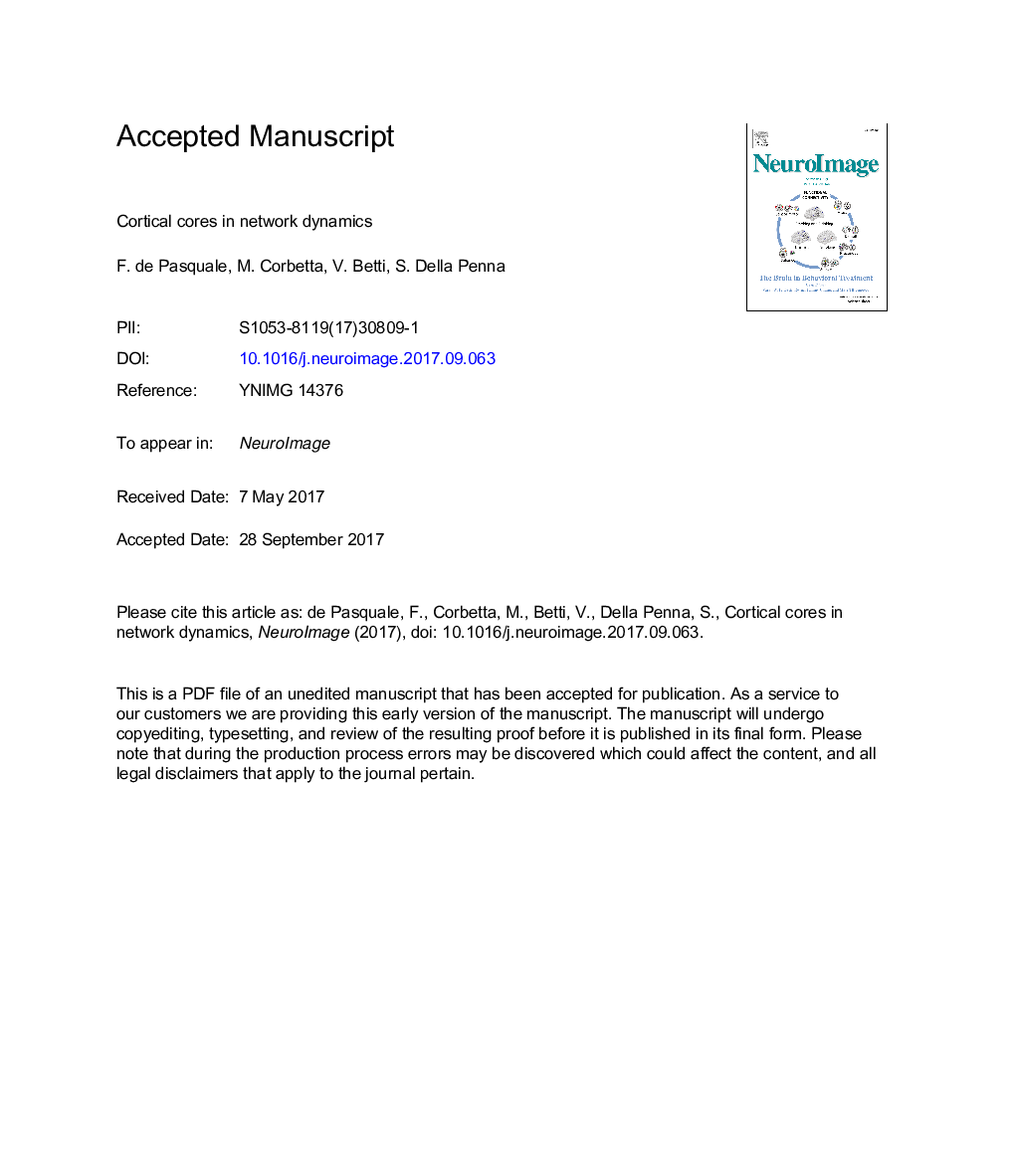| کد مقاله | کد نشریه | سال انتشار | مقاله انگلیسی | نسخه تمام متن |
|---|---|---|---|---|
| 8957309 | 1646207 | 2018 | 30 صفحه PDF | دانلود رایگان |
عنوان انگلیسی مقاله ISI
Cortical cores in network dynamics
ترجمه فارسی عنوان
هسته های کرکی در پویایی شبکه
دانلود مقاله + سفارش ترجمه
دانلود مقاله ISI انگلیسی
رایگان برای ایرانیان
ترجمه چکیده
فعالیت مغزی خود به خودی در حالت استراحت به طور فضایی و به طور موقت در شبکه هایی از مناطق کورتنی و زیر کورتنی که برای دامنه های مختلف کاربردی تخصصی هستند، سازمان یافته است. اگر چه شبکه های مغز به طور جداگانه از طریق تصویربرداری رزونانس مغناطیسی به طور جداگانه مورد مطالعه قرار گرفتند، مطالعات اخیر بیشتر بر روی ادغام پویایی خود تمرکز کرده اند. ادغام به دو ویژگی اساسی بستگی دارد: توپولوژی ساختاری شبکه های مغز و پویایی اتصال قابلیت های کاربردی. در این سناریو، مناطق مرکزی قشر که مناطق مرکزی بسیار متصل به مناطق دیگر مغز هستند، نقش اساسی در خدمت به عنوان ایستگاه راه برای ترافیک شبکه ایفا می کنند. در این بررسی، ما تمرکز ما بر سازماندهی عملکردی مجموعه ای از مناطق توپی است که ما آن را به عنوان هسته پویایی تعریف می کنیم. در حالت استراحت، این مناطق به طور پویا با دیگر مناطق مغز ارتباط چندین شبکه ارتباط برقرار می کنند. ابتدا ما مقادیر آماری مورد استفاده برای شناسایی هاب ها را معرفی و مقایسه می کنیم. دوم، ما در مورد شناسایی آنها بر اساس روش های مختلف (تصویربرداری رزونانس مغناطیسی عملکردی، تصویربرداری وزن توزیع، الکترو / مغناطیس انسفالوگرافی) بحث می کنیم. سوم اینکه ما نشان می دهیم که درجه تعامل بین این مناطق هسته و بقیه مغز در طول زمان تغییر می کند و نشان می دهد که مرکزیت آنها ثابت نیست. علاوه بر این، دوره های متناوب مرکزیت قوی و ضعیف هسته مربوط به دوره های کارآیی قوی و ضعیف جهانی در مغز است. این نتایج نشان می دهد که پردازش اطلاعات در مغز پایدار نیست، اما نوسان می کند و خواص زمانی و طیفی آن بحث می شود. به طور خاص، فرضیه پردازش اطلاعات "پالسی"، کشف شده در مقیاس آرام زمانی، برای سیگنال ها در رزولوشن زمانی بالاتر بررسی می شود.
موضوعات مرتبط
علوم زیستی و بیوفناوری
علم عصب شناسی
علوم اعصاب شناختی
چکیده انگلیسی
Spontaneous brain activity at rest is spatially and temporally organized in networks of cortical and subcortical regions specialized for different functional domains. Even though brain networks were first studied individually through functional Magnetic Resonance Imaging, more recent studies focused on their dynamic 'integration'. Integration depends on two fundamental properties: the structural topology of brain networks and the dynamics of functional connectivity. In this scenario, cortical hub regions, that are central regions highly connected with other areas of the brain, play a fundamental role in serving as way stations for network traffic. In this review, we focus on the functional organization of a set of hub areas that we define as the 'dynamic core'. In the resting state, these regions dynamically interact with other regions of the brain linking multiple networks. First, we introduce and compare the statistical measures used for detecting hubs. Second, we discuss their identification based on different methods (functional Magnetic Resonance Imaging, Diffusion Weighted Imaging, Electro/Magneto Encephalography). Third, we show that the degree of interaction between these core regions and the rest of the brain varies over time, indicating that their centrality is not stationary. Moreover, alternating periods of strong and weak centrality of the core relate to periods of strong and weak global efficiency in the brain. These results indicate that information processing in the brain is not stable, but fluctuates and its temporal and spectral properties are discussed. In particular, the hypothesis of 'pulsed' information processing, discovered in the slow temporal scale, is explored for signals at higher temporal resolution.
ناشر
Database: Elsevier - ScienceDirect (ساینس دایرکت)
Journal: NeuroImage - Volume 180, Part B, 15 October 2018, Pages 370-382
Journal: NeuroImage - Volume 180, Part B, 15 October 2018, Pages 370-382
نویسندگان
F. de Pasquale, M. Corbetta, V. Betti, S. Della Penna,
